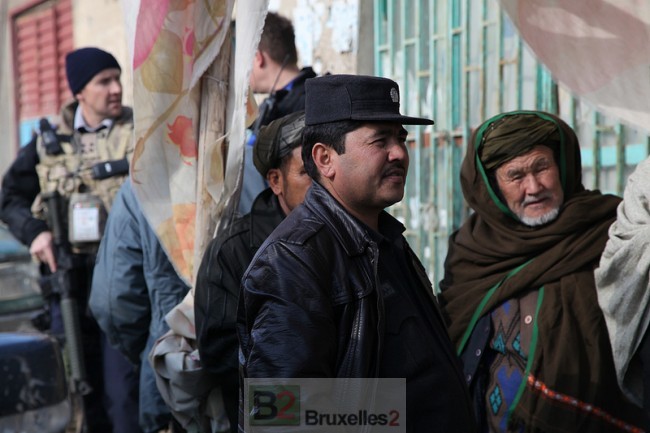2014, a year of crises… And it's not over in 2015!

(BRUSSELS2) In the world, the conflicts around the European continent did not disappear during the year 2014. On the contrary! And the ministers of foreign affairs or defense of the Union will have a lot to do this year to try to curb these crises as well as to harmonize their positions.
A "myriad" of conflicts, closer
The proliferation of conflicts is nothing new. The specificity today is that they have become both more intense and above all closer to the European level, whether in the Middle East or in the East of the continent. This is the main challenge in 2015. While ten years ago there were many conflicts (Afghanistan-Pakistan, Somalia, Iraq, Congo, etc.), they were also more distant. Europeans could be involved, but more or less directly. And they had a less direct impact on the European sphere as a whole. (*)
Strong internal repercussions
The "myriad" of current threats thus presents three particular characteristics which, without being completely new, have rarely been brought together at the same time. Firstly, it constitutes an almost complete belt of European borders: from the East to the South, from the Baltic to the south of Sardinia. "The arc of crises" - from Pakistan to Mauritania, even the Ivory Coast - described in the French White Paper in 2008 - has thus come particularly close, from Russia to Libya. The impact is therefore more direct for Europe, whether at the economic level (loss of markets or support for countries in difficulty), social (influx of refugees, etc.), or security (terrorism, foreign fighters, etc.). ). These conflicts also have very political repercussions at the internal level, forcing positions to be constantly readjusted: on Russia (between supporters of a hard line or not), on Bashar or the Syrian opposition, on Palestine, on the immigration, on the delivery of arms to this or that belligerent. Last point of differentiation: the "adversaries" on certain fronts also turn out, directly or indirectly, to be "allies" on other areas of dispute or conflict (Russia in the Middle East, Iran, Syria or the Hezbollah against the Islamic State). This is particularly difficult to manage. We can also wonder about the "bad" management or even the advisability of past military interventions and the management of the post-crisis (Iraq, Libya, etc.) which today are proving to be not only a failure but a hazard.
From East to South
The dispute Ukrainian experienced different upheavals: from the “revolution” of February and the departure of Yanukovych, which sowed a wave of hope, to a Russian intervention to recover the Crimean peninsula and an economic collapse of the country. An intervention, carried out in a masked way at the start, with soldiers without acronym or flag and equipped with light weapons, quickly and with almost no victims. This intervention then continued in eastern Ukraine, in the Donbass, in a much bloodier way. A conflict that continues, even if the Minsk agreements have programmed a de-escalation. As a consequence, tensions with Russia have worsened, on many aspects (political, economic, military etc.) up to the Baltic.
The dispute Syria is in its fourth year, the balance sheets follow one another, always more deadly. The number of refugees in neighboring countries continued to grow, putting significant pressure on Jordan in particular (read: The Syrian conflict continues. The refugees stay. Report from Jordan) where the Lebanon. The Cedar country has managed to "hold on" despite growing tension at its borders, and inside the country, particularly in Tripoli. Each time, we believe that the limit has been reached. Each time, she is pushed back. Until when ?
The presence of radical militias in Syria is proving to be as dangerous, if not more so, than Bashar's government for the countries of the region and Westerners. An international coalition set up to fight against one of them in particular, the organization ofIslamic state who entered into Iraq, routed the Iraqi army and jostled even the Kurdish peshmergas. This intrusion has destroyed the American withdrawal strategy. And, for the third time in 20 years, an international coalition has come together in the region to try to contain what looks like a new threat.
In the Middle East, these are not the only sources of instability. THE Yemen is sinking into a zone of serious instability, a quasi-falli state reminiscent of Somalia in the 1990s, in a rather generalized indifference (read: conflicting strabismus). A total implosion is no longer to be excluded with already significant consequences in terms of the "nest" of terrorism. As for the conflict between Israel and Palestine turns, for the moment, to a diplomatic "intifada", it could experience a new, more acute crisis, as it experienced with the offensive on Gaza (operation Protective border ou Steadfast Rock).
La Libya continues to sink into a heightened level of instability. The presence of two governments, of fighting between the different militias does not bode well. The hope of a national reconciliation negotiation is still hoped for, with the efforts of the UN mediator, the Spaniard Bernadino Leon. A pressing problem for Europe made a point of alerting the French Minister of Defense, Jean-Yves Le Drian, before Christmas. He's not the only one worried. Italy and Spain, at European level, have also insisted on the need to act.
Unknowns, zones in stabilization... or not?
En Afghanistan. , the end of the NATO stabilization operation ends with a certain discretion and in a certain unknown. The question now is how long the government and the new Afghan army trained by the West will hold out against possible Taliban offensives but also internal divisions.
En Africa, the various areas of crisis noted in recent years — Somalia, Mali, and even the Central African Republic — are tending to improve, stabilize or, at the very least, avoid worsening more markedly. It also shows that a military intervention, wisely, accompanied by a whole political, development and humanitarian process, is not useless. The Somali example, on which nobody bet a kopeck since 1992, shows that there is nothing irreversible.
In general, the situation throughout the Sahel, and at its edges, from Sudan au Nigeria, remains critical, from the point of view of internal security and the stability of countries. With a real stranger. The Maghreb remains, for the moment, stable. But the hypothesis of a repercussion of Libyan instability on neighboring Tunisia is not excluded. While the future of Algeria worries all specialists.
"Old" conflicts in the process of attenuation?
In this very bleak horizon, we must not deny certain areas of conflict in the process of appeasement. With the ceasefire declared by the FARC in Colombia, and on a completely different level, the re-establishment of diplomatic relations between Cuba and the United States, Latin and Central America is fully rediscovering the path of a peaceful atmosphere. Who would have believed it 20 years ago...?
What is also happening at Sri Lanka, with the commitment to a peace process between the central government and the Tamils is encouraging. The same is true of the opening of Burma. The Iranian nuclear negotiations, if they finally succeed in June, could also end years of tension with Tehran. Iran could thus regain a certain legitimacy and normality on the international scene. Which is not useless today.
Good news too, in the Gulf of Aden and the entire Indian Ocean, the threat of piracy of Somali origin is now virtually suppressed. To the west of the continent, in the Gulf of Guinea, tension with local pirates certainly remains at a high level. But various measures taken (training, equipment, networking of the forces of the neighboring countries) suggest a possible way out of the crisis.
The resurgence of external and internal terrorism
This table would remain, in fact, incomplete if we do not take into account the new situation resulting from the attack in Paris against "Charlie hebdo" which follows that of the Jewish museum in Brussels. An attack committed by "insiders" - as had been those of extremist left or right movements in the 1970s - but trained outside and invoking (misguidedly) the defense of a religious ideal. A double deal that will significantly complicate crisis management. Because it largely involves other elements than the only security point. Outside, representations or European citizens could also be the target of "terrorists", just like places of power, democracy or simply everyday life inside European countries. This "terrorism" could also have a political wind effect: to split a little more a European society, weakened by years of economic and social crisis, intense since 2008-2009, and to favor extreme movements, surfing on a new wave of racism both anti-Muslim and anti-Jew. Worst case scenario, worst threat...
Happy New Year...
(Nicolas Gros-Verheyde)
(*) One exception must be mentioned: the war in the Balkans in the early 1990s. But we were in another configuration, with a Europe of Twelve, a Russia which had remained orphaned by the USSR, weak on the world stage.
